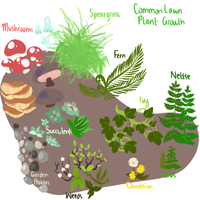Profile
Basic info:
Paraspone Wyrms are parasites that attach themselves to creatures they choose to be their host. They insert roots into their hosts via hair follicles, and grow on pony species often as the mane and tail offer wider follicles to inhibit.
Once attached, the parasite will release serotonin (happy feel-good chemical) and dopamine (cuddle/comfort chemical) into their host, giving the host a good feeling and generally welcoming of it's new companion. The relationship of the two is like that of good roommates; friendly and happy to be together.
The parasite leeches nutrients from its host, and gets all oxygen and fluids the same way.
There are two types of Paraspone Wyrms, tails, which attach to the tail end of the host, and manes, which attach at the mane or head of the host, sitting like a headdress. Mane parasites accommodate their lawn of the chest of the host, having it resemble chest fluff.
Behavior:
The behavior of Paraspone Wyrms varies. It depends on its rarity, and whether it is a tail type or a mane type.
Whether or not the parasite and the host get along, the parasite will always be extremely protective of its host, as that is its life source. Tail parasites will guard their host, snapping and biting at nearby possible threats.
Mane parasites have a more extreme protection method. If the pony/parasite feels under threat, it will clamp down over the pony, temporarily taking control of the hosts body and, ready to attack or flee.
The parasite will eventually grow to trust those that the host trust, even guarding them as they guard and protect their host.
Rarities and Traits
Parasite head and neck:
Common eg.
Common Parasites are animalistic, but intelligent. They are powered by instinct. They are capable of chirps, purrs, and low guttural growls.
Rare eg.
Rare Parasites have a lot more brain power, and can understand speech, though they cannot talk properly. They are easily trainable to communicate through other ways, and be of assistance to their host.
Legendary Parasites are very wise. They can communicate through language, and are eager to learn. They are much more calm when defending their hosts, and will only attack when a real threat arises.
Parasite Base and Lawn:
Parasites will keep a piece of their original environment and implant it when they find a host, letting plants, flowers, and even small bodies of water thrive.
Number of Parasites.
It is possible for a single creature to host up to three parasites. Any more, and the host would not be able to survive.
The rarity of the amount is as follows:
Reproduction.
Paraspone Wyrms reproduce asexually, creating pollen-like spores on from the foliage on their lawn. These spores take shelter in forests and bushy areas, germinating til they are mature and able to search for a host. They move similar to a caterpillar.
The parasite does not interfere with regular reproduction of its host (though breeding may be a little awkward...), and takes great care of the youth of its host.
This species has been so much fun to work on! I've made a lot of effort not to conflict with other species out there. I'm hoping I was successful!!
Currently rights are not open, but MYOs are! Message me for a quote :)
Any questions? Please re-read the info (just in case) then feel free to ask me anything!
Thanks for having a peep!






Comments